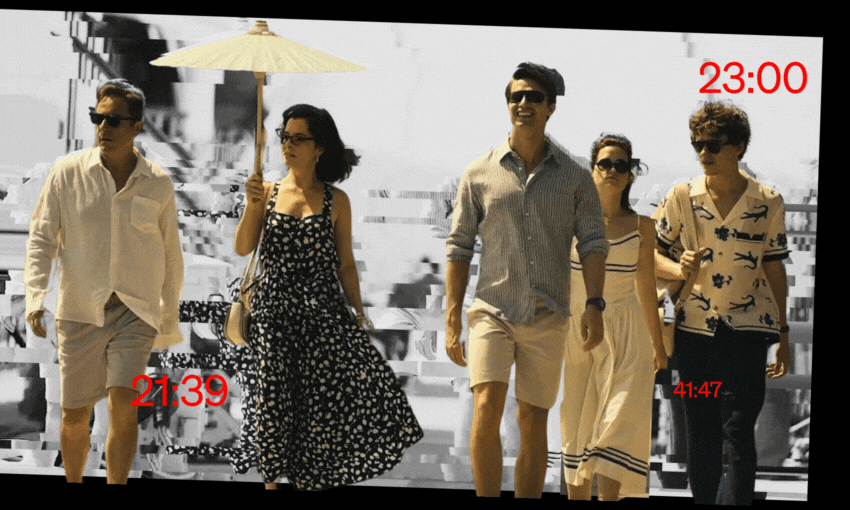While we wait for sensible drug law reform, we can thank our lucky stars for the NZ Drug Foundation and the lifesaving – or at the very least, bad-trip-preventing – work they do testing drugs at music festivals.
Aotearoa’s summers are typically marked by an influx of sketchy party drugs and avoidable harm. This year has been no different. During the last three days of 2022, at the Rhythm & Vines festival in Gisborne, the New Zealand Drug Foundation found 25B-NBOH – a potent psychedelic and stimulant – in samples presented as LSD.
Like many modern designer drugs, or novel synthetic substances, not much is known about the potential toxicity of 25B-NBOH. But Drug Foundation executive director Sarah Helm said similar substances like 25i-NBOMe had caused hospitalisations, psychosis and death in New Zealand and worldwide.
“25B-NBOH can be active even at very tiny doses, so it’s difficult to dose accurately and may increase your risk of overdose,” she said.
Helm is warning it may still be in the community.
25B-NBOH? It sounds a little Blade Runner
25B-NBOH is in a class of drugs intended to mimic the effects of more traditional psychedelic substances. They’re the sort of things people often call “bath salts” – though that label more correctly applies to compounds that are either too obscure to legislate, or intentionally designed to avoid existing laws. Unlike more common drugs like meth, for example, they don’t generally have their own widely-recognised street names.
Because New Zealand is such a small market, the drug scene changes quickly, and supply issues caused by the Covid-19 pandemic have reduced the availability of more mainstream substances like MDMA, cocaine or LSD.
The 25B-NBOH found at Rhythm & Vines was sold on paper tabs and misrepresented as LSD. Some of the tabs, quite poetically, were pink and featured an image of Pickle Rick from the animated sitcom Rick and Morty. As well as being ethically wrong, misrepresenting drugs can lead to dosing mistakes and harmful interactions with other substances when the person taking them is unable to safely assess the risks of a particular combination.
What else did they find?
The usual synthetic cathinones – dimethylpentylone, eutylone and a variety of other mysterious-sounding compounds – as well as your more typical festival fare.
How do we know all this?
The New Zealand Drug Foundation, as well as other organisations at events around the country, operated a testing booth at Rhythm & Vines which was open to any festival-goer to get their drugs tested openly and free of charge.
Because of these programs we have a pretty good idea of conditions on the ground. For example, 78% of substances tested turned out to be as expected. Another 12% were a different drug entirely, and 10% had a little something extra mixed in. Most commonly, cathinones were being sold as, or with, MDMA, but benzodiazepines, amphetamines and cocaine had been adulterated too.
This data is interesting, and cited internationally, but it also helps harm reduction services at home prepare for impending health implications. The detection of fentanyl, an opioid which has killed more than 100,000 people in the USA, bolstered the foundation’s calls for increased supplies of Narcan (used to counter opioid overdoses) in Aotearoa.
Drug checking hasn’t always been legal. Legendary pioneers KnowYourStuffNZ were founded as a volunteer organisation in 2015 by Wendy Allison – or Wendy Allison ONZM as she is following the latest New Year Honours – after a wave of novel psychedelics and adulterated substances hit Aotearoa with an accompanying increase in medical events. At that time, drug checking operated in a grey area, and providers took a very real risk they would be prosecuted for their work.
Then in 2020, Aotearoa became the first country to have explicitly legal drug checking.
These programs have prevented untold harm including death and serious injury by identifying dangerous substances and helping users make informed decisions about the drugs they choose to take – or to throw away, as more than 60% of clients did in 2021/2022 upon learning their bag was full of mystery powder.
That all sounds great. What’s the catch?
It sounds great because it is. If there’s a downside, it’s that outdated drug laws make these services so essential.
Prohibition creates an incentive for the illegal market to produce new and more potent drugs, with novel associated harms, and funnel huge sums into the hands of unscrupulous parties.
Drug checking organisations do a priceless job, but part of the reason their work is so vital is because of the market conditions which make comparatively dangerous and unknown drugs so viable to sell. Regulation reduces that motive and therefore the risk to users. Sensible reform is just a legislative amendment away.
Recent shifts towards treating drug use as a health, and not criminal, issue have undoubtedly been a move in the right direction. Legalised drug checking has enabled harm reduction organisations to protect and inform users. But as history shows, prohibition doesn’t prevent much at all.
In the meantime, while we wait for common sense drug law, organisations like the New Zealand Drug Foundation, KnowYourStuffNZ and the New Zealand Needle Exchange will be testing at a festival or clinic near you.
This is Public Interest Journalism funded through NZ On Air.



